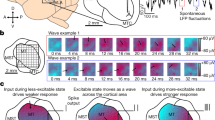Abstract
Traveling waves appear in various signals that measure neuronal activity. Some signals measured in animals have singles-cell resolution and directly point to neuronal activity. In those cases, activation of distributed neurons forms a wave front, and the front propagates across the cortical surface. Other signals are variants of neuroelectric potentials, i.e. electroencephalography, electrocorticography and field potentials. Instead of having fine spatial resolution, these signals reflect the activity of neuronal populations via volume conduction (VC). Sources of traveling waves in neuroelectric potentials have not been well addressed so far. As animal studies show propagating activation of neurons that spread in measured areas, it is often considered that neuronal activations during scalp waves have similar trajectories of activation, spreading like scalp waves. However, traveling waves on the scalp differ from those found directly on the cortical surface in several dimensions: traveling velocity, traveling distance and areal size occupied by single polarity. We describe that the simplest sources can produce scalp waves with perceived spatial dimensions which are actually a magnification of neuronal activity emanating from local sources due to VC. This viewpoint is not a rigorous proof of our magnification concept. However, we suggest the possibility that the actual dimensions of neuronal activity producing traveling waves is not as large as the dimension of the traveling waves.

Similar content being viewed by others
References
Bastos AM, Vezoli J, Fries P (2015) Communication through coherence with inter-areal delays. Curr Opin Neurobiol 31:173–180
Bressler SL, Richter CG (2015) Interareal oscillatory synchronization in top-down neocortical processing. Curr Opin Neurobiol 31:62–66
Buzsáki G, Logothetis N, Singer W (2013) Scaling brain size, keeping timing: evolutionary preservation of brain rhythms. Neuron 80:751–764
Delorme A, Makeig S (2004) EEGLAB: an open-source toolbox for analysis of single-trial EEG dynamics. J Neurosci Meth 134:9–21
Einevoll GT, Kayser C, Logothetis NK, Panzeri S (2013) Modelling and analysis of local field potentials for studying the function of cortical circuits. Nat Rev Neurosci 14:770–785
Ermentrout GB, Kleinfeld D (2001) Traveling electrical waves in cortex: insights from phase dynamics and speculation on a computational role. Neuron 29:33–44
Fellinger R, Gruber W, Zauner A et al (2012) Evoked traveling alpha waves predict visual-semantic categorization-speed. NeuroImage 59:3378–3388
Halgren M, Ulbert I, Bastuji H et al (2019) The generation and propagation of the human alpha rhythm. Proc Natl Acad Sci USA 116:23772–23782
Herreras O (2016) Local field potentials: myths and misunderstandings. Front Neural Circuits 10:101
Hindriks R, van Putten MJAM, Deco G (2014) Intra-cortical propagation of EEG alpha oscillations. NeuroImage 103:444–453
Hindriks R, Arsiwalla XD, Panagiotaropoulos T et al (2016) Discrepancies between multi-electrode LFP and CSD phase-patterns: a forward modeling study. Front Neural Circuits 10:51
Joyce C, Rossion B (2005) The face-sensitive N170 and VPP components manifest the same brain processes: the effect of reference electrode site. Clin Neurophysiol 116:2613–2631
Kajikawa Y, Schroeder CE (2015) Generation of field potentials and modulation of their dynamics through volume integration of cortical activity. J Neurophysiol 113:339–351
Kajikawa Y, Smiley JF, Schroeder CE (2017) Primary generators of visually evoked field potentials recorded in the macaque auditory cortex. J Neurosci 37:10139–10153
Lakatos P, Chen CM, O’Connell MN et al (2007) Neuronal oscillations and multisensory interaction in primary auditory cortex. Neuron 53:279–292
Lozano-Soldevilla D, Van Rullen R (2019) The hidden spatial dimension of alpha: 10-Hz perceptual echoes propagate periodic traveling waves in the human brain. Cell Rep 26:374–380
Lubenov EV, Siapas AG (2009) Hippocampal theta oscillations are traveling waves. Nature 459:534–539
Massimini M, Huber R, Ferrarelli F et al (2004) The sleep slow oscillation as a traveling wave. J Neurosci 24:6862–6870
Muller L, Reynaud A, Chavane F et al (2014) The stimulus-evoked population response in visual cortex of awake monkey is a propagating wave. Nat Commun 5:3675
Muller L, Chavane F, Reynolds J et al (2018) Cortical travelling waves: mechanisms and computational principles. Nat Rev Neurosci 19:255–268
Murphy M, Riedner BA, Huber R et al (2009) Source modeling sleep slow waves. Proc Natl Acad Sci USA 106:1608–1613
Nunez PL, Srinivasan R (2005) Electric fields in the brain. The neurophysics of EEG. Oxford University Press, Oxford
Rubino D, Robbins KA, Hatsopoulos NG (2006) Propagating waves mediate information transfer in the motor cortex. Nat Neurosci 9:1549–1557
Sato TK, Nauhaus I, Carandini M (2012) Traveling waves in visual cortex. Neuron 75:218–229
Schmolesky MT, Wang Y, Hanes DP et al (1989) Signal timing across the macaque visual system. J Neurophysiol 79:3272–3278
Stroh A, Adelsberger H, Groh A et al (2013) Making waves: initiation and propagation of corticothalamic Ca2+ waves in vivo. Neuron 77:1136–1150
Wilson HR, Cowan JD (1972) Excitatory and inhibitory interactions in localized populations of model neurons. Biophys J 12:1–24
Yoshor D, Bosking WJ, Ghose GM et al (2007) Receptive fields in human visual cortex mapped with surface electrodes. Cereb Cortex 17:2293–2302
Zhang H, Jacobs J (2015) Traveling theta waves in the human hippocampus. J Neurosci 35:12477–12487
Zhang H, Watrous AJ, Patel A, Jacobs J (2018) Theta and alpha oscillations are traveling waves in the human neocortex. Neuron 98:1269–1281
Funding
This study was supported by NIH Grants F32DC015391 and R01DC015780.
Author information
Authors and Affiliations
Corresponding author
Ethics declarations
Conflict of interest
Authors declare no conflicts of interest.
Additional information
Handling Editor: Benedetta Franceschiello.
Publisher’s Note
Springer Nature remains neutral with regard to jurisdictional claims in published maps and institutional affiliations.
This is one of several papers published together in Brain Topography on the “Special Issue: Computational Modeling and M/EEG”.
Rights and permissions
About this article
Cite this article
Orczyk, J.J., Kajikawa, Y. Magnifying Traveling Waves on the Scalp. Brain Topogr 35, 162–168 (2022). https://doi.org/10.1007/s10548-021-00853-1
Received:
Accepted:
Published:
Issue Date:
DOI: https://doi.org/10.1007/s10548-021-00853-1




